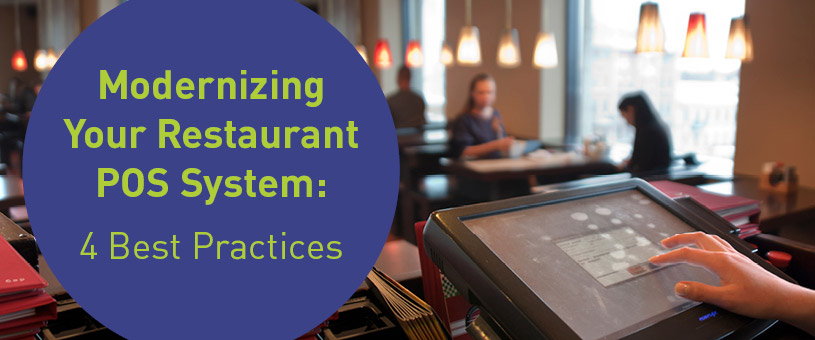Modernizing Your Restaurant POS System: Four Best Practices
6 Min Read By Ohad Jehassi
If you’ve been in the restaurant business while, you may think you’re too accustomed to your legacy POS system to make the switch to a new one. You’ve seen your colleagues and competitors upgrade their systems and you’re coming to terms with the truth: a modern POS system can lead to new business, less hassle, and greater efficiency for your restaurant. And while the transition may seem daunting, the benefits are likely too good to pass up, especially in such a competitive market.
Through the process, keep in mind these keys to making your POS transition as painless as possible:
- Ask associates about their experiences
- Let your staff in on the process
- Determine your priorities and make a choice
- Implement strategically
By incorporating these best practices into your plan, you can ease your transition to a modern POS platform and take your restaurant into the 21st century.

Luckily, there are plenty of restaurants and other businesses that have paved the way for you. If you’ve been in the industry a while, you likely know other restaurateurs and small business owners who have made the transition to a modern POS system. Ask them about their experiences to get a picture of the challenges you will face throughout the process.
Some of the most helpful questions you can ask:
What brand of POS did you choose, and are you satisfied with your choice?
What unexpected challenges did you face in the transition?
How long did you plan for the transition to take, and did you meet that goal?
How difficult was the actual installation of the new system?
What complaints have your employees had about the new system and/or the transition process?
What do you wish you had done differently?
How does your system handle payment processing? (For an introduction to this subject, see Double The Donation’s guide to payment processing.)
Online reviews are helpful as well, but it is definitely worth taking the time to talk to someone you know so you can ask any specific questions that the internet may not address.
Remember that you are not necessarily trying to find the best POS system—just the one that will work best for your restaurant.

Only you can decide what system to implement, but it’s also important that you ask your staff their thoughts.
They use the restaurant POS system as much or more than you, so it only makes sense to take into account their needs as well as yours when making your decision.
This process can also serve as a sort of “pre-training” by introducing your staff to some of the important concepts and possible changes they will encounter. If you are considering a major switch, like one from a legacy to a mobile POS (more on mPOS later), ask them if they have any anxieties or concerns regarding the change.
Then, keep them involved as you weigh the options and begin installing your new system. Continue to brief them on your decisions and ask them for feedback so they never feel left out of the process. The more engaged your employees are throughout the installation of your new POS system, the more comfortable they will be with it when it goes live.

Now that you’ve learned what to watch out for, collected the names of a few brands, and heard from your employees, it’s time to determine what features your restaurant needs and, ultimately, what POS system you want to go with.
One of the first questions you should ask about your next restaurant POS is whether or not you want a mobile system. Mobile point-of-sale (or mPOS) systems offer a range of features that can revitalize your restaurant’s preparation and service processes. Consider this option if you are ready for a significant change in the way your restaurant operates.
mPOS systems enable your servers to take and send orders, charge customers, handle electronic signatures, and show suggested tip options, all right from the table. These types of features generate extra efficiency which can lead to improved table turn and better revenue.
But many restaurants prefer not to implement such a significant change, and will choose to stick with a stationary POS option. For these businesses, a more modern system can still offer a slew of time-saving features while taking up less space than legacy systems.
While the choice between a mobile and stationary system will be one of the most influential decisions you make, there are many others things to consider as well:
Does the system track and compile data to help you manage your business? Most modern POS systems offer much more sophisticated data tracking and business analytics features than legacy systems. Weigh these against your management practices to make a decision that works for you.
Does the interface design work with your methods/does it offer significant customization? Only you and your staff know what works best for your restaurant. You may want to customize your new interface so it resembles your current one to minimize the need for training, or you may want to overhaul your interface to improve efficiency.
Is it secure? Unlike the above decisions, this should be influenced less by personal preference than by industry standards. A digital POS has to be secure, so make sure that your new system is PCI compliant and meets other cybersecurity guidelines so you never experience a hack or other emergency.
Does it work well with online ordering? If your restaurant receives a lot of business through online orders, you’ll want to make sure your new system supports that. Some systems can send orders straight to the kitchen from the web, saving a step for your restaurant’s host or cashier. This is an especially useful POS feature for business such as pizza parlors.
If you don’t already have several specific requirements in mind for your new POS, these questions will help get you started with the research process. As you learn more about the options, you’ll develop an understanding of your needs so you can choose the right system for your restaurant— and then start the transition.

Now it’s time to actually get rolling with the new system. Follow these steps to make the installation as smooth as possible so you can get back to work:
Data backup
Your data is important to your business, so you shouldn’t be forced to lose it when you make the switch to a new POS.
Your legacy POS system likely has an internal hard drive full of various data it has collected through the years. If you aren’t willing to start fresh with your new system, or just want to hold on to the data from the last few months, you’ll have to back it up.
If your system runs on Unix or Windows, it will probably be a fairly straightforward process. Check your system’s file menu for an option that says “backup/restore” and follow the prompts. Your new POS provider should offer implementation services to ensure that you get every piece of the transition process right.
You should also check the brand’s website for a more detailed guide on how to backup the database. Consult this information for hardware and software tips that will help you save all your data. As long as you have a cloud solution or hard drive that can connect to your new system, it shouldn’t be a problem to import the data and get it up and running.
Installation
Because the transition will inevitably require some disruption of normal business, try to schedule the most disruptive tasks during times when your staff won’t be too busy. Whether that means waiting until a slow season or a slow day, being strategic in this part of the process can save a lot of trouble.
Any period in which the POS system will have to be down momentarily should happen during a time with as little traffic as possible. This includes the first time you boot up the new system, as it will likely have to be configured before it’s ready to go.
Most managers say one of the most important selling points of a new POS platform is a simple simple installation process to minimize downtime. Check product reviews to find out about other customers’ experiences. Even if you can schedule your installation for after hours, you don’t want to waste your valuable free time setting up your POS.
Training
Now’s the time to give your staff a formal, comprehensive introduction to the new system. This time, the goal is to get them as close to work-ready as possible. Developing a working knowledge of the system yourself is the first and most important step in this process.
Consider choosing a brand that provides users with videos and guides for learning their POS system. Go through the guides yourself and then pass them on to your employees so you can go through them together. Getting everyone on the same page is the last step to implementing your new system.
Making the change to a modern restaurant POS system will likely require some adjustments by your restaurant—don’t make it harder than it has to be. Taking the above factors into account will make for a quick and simple transition.


